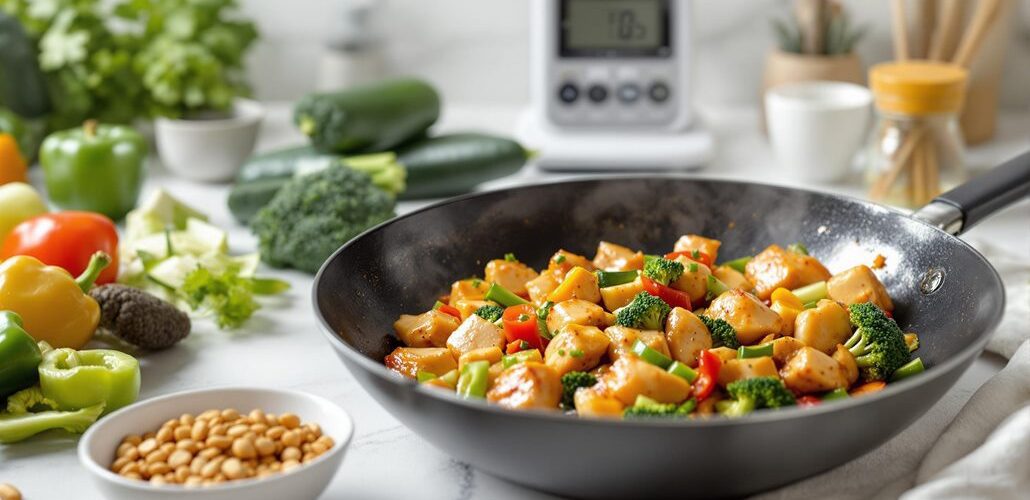
To calculate the carbohydrates in homemade Kung Pao Chicken, analyze each ingredient and their respective portions. The chicken itself is carb-free, but the sauce can contribute 5-10 grams of carbs per serving due to sugar, soy sauce, and cornstarch. Including vegetables such as bell peppers adds approximately 6 grams of carbs per 100 grams, while peanuts add 16 grams per 100 grams. Be cautious with rice or noodles, as they can greatly increase carb count; one cup of cooked rice contains around 45 grams of carbs. Monitoring serving sizes and using nutritional databases can help track and manage dietary goals effectively. Discover additional strategies for precise carb tracking.
Key Takeaways
- Measure ingredients accurately using digital scales and measuring cups for precise carbohydrate tracking.
- Utilize online nutritional calculators with specific brand inputs for accurate macronutrient analysis.
- Consider portion sizes; doubling increases carb intake, so maintain portion control for dietary goals.
- Calculate net carbs by subtracting fiber from total carbs to manage dietary intake effectively.
- Monitor sauce ingredients closely as they significantly influence total carbohydrate content.
Understanding Carbohydrate Sources
Understanding the sources of carbohydrates in Kung Pao Chicken is essential for those aiming to manage their carb intake effectively. Typically, a serving of this dish contains around 6.9 grams of carbohydrates, where sugars account for approximately 3 grams.
The nutrition profile of Kung Pao Chicken is primarily influenced by the specific ingredients used, particularly the sauce and vegetables. Sauces often include sugar, a key contributor to the carbohydrate content. Additionally, vegetables such as bell peppers, while providing nutritional benefits, add small amounts of carbs.
Choosing the right non-starchy vegetables can help maintain a low-carb profile for the dish, aligning with keto guidelines. The carbohydrate content can vary greatly based on the preparation method and accompanying sides. For instance, if Kung Pao Chicken is served with rice or noodles, the overall carbohydrate content of the meal increases dramatically. Rice, a common accompaniment, has about 45 grams of carbohydrates per cooked cup, while the carbohydrate content in noodles varies widely depending on their type.
For those preparing Kung Pao Chicken at home, adjusting the amount of sugar in the sauce and selecting low-carb vegetables can help in tailoring the dish to individual dietary needs. This strategic approach allows for a balanced nutritional intake, aligning with specific health goals.
Ingredient Analysis for Carbs
In analyzing the carbohydrate content of Kung Pao Chicken, it is essential to evaluate the contribution of the sauce, which accounts for approximately 3 grams of sugar per serving, largely influencing the dish's overall carbohydrate profile.
Incorporating non-starchy vegetables like bell peppers and onions not only adds minimal carbs but also provides essential nutrients and fiber, enhancing the meal's health benefits.
Additionally, using unsweetened beverages alongside keto-friendly dishes can further align with low-carb dietary preferences.
Meanwhile, the chicken itself contains negligible carbohydrates, ensuring that the primary sources of carbs are the sauce and accompanying ingredients, aligning the dish with low-carb dietary preferences.
Sauce Carb Content
A vital component of evaluating the carbohydrate content in Kung Pao Chicken lies in the analysis of its sauce ingredients. The sauce carb content is primarily influenced by common ingredients such as soy sauce and sugar. Importantly, sugar acts as a considerable source of simple carbohydrates, contributing approximately 3 grams to the overall carbohydrate profile of the dish. Additionally, modified food starch, often utilized as a thickening agent, adds extra carbohydrates, further impacting the sauce carb content.
To gain a clearer understanding, consider the table below which outlines the carbohydrate contribution from key sauce components:
| Ingredient | Carb Contribution (grams) | Role in Sauce |
|---|---|---|
| Sugar | 3 | Sweetener |
| Soy Sauce | 1 | Flavor Enhancer |
| Modified Food Starch | Variable | Thickening Agent |
Analyzing these ingredients is essential for those preparing Kung Pao Chicken at home, as the carbohydrate content can vary greatly based on the amount of sugar and thickener used. Thus, precise measurement of each component is vital for accurate carb calculation. This meticulous approach not only aids in maintaining dietary goals but also enhances awareness of nutritional intake, emphasizing health-conscious cooking practices.
Vegetables and Carbs
When evaluating the carbohydrate content in Kung Pao Chicken, attention must be given to the vegetables included in the dish.
Vegetables such as bell peppers and celery are common ingredients that contribute to the overall carbohydrate profile. For instance, bell peppers contain approximately 6 grams of carbs per 100 grams, which can notably impact the dish's nutritional composition.
It is essential to understand how each vegetable affects carb totals to make informed dietary choices.
Consider the following analysis:
- Bell Peppers: With about 6 grams of carbs per 100 grams, bell peppers are a moderate source of carbohydrates, influencing the dish's overall carb count.
- Peanuts: While not a vegetable, peanuts are often included and add approximately 16 grams of carbs per 100 grams, greatly increasing the carbohydrate content.
- Mushrooms: These are low-carb vegetables, containing only about 3 grams of carbs per 100 grams, making them an ideal option for those looking to reduce carb intake.
- Sauce Ingredients: Typically containing sugar, the sauce contributes additional carbs, with just one tablespoon of sugar adding around 13 grams.
Chicken and Carbohydrates
Understanding the role of chicken in the carbohydrate content of Kung Pao Chicken is essential for those managing their dietary intake. Chicken itself is a protein-rich ingredient that contains negligible carbohydrates, making it an ideal choice for those seeking to minimize carb intake. However, the overall carbohydrate content in Kung Pao Chicken, typically around 6.9 grams per serving, is influenced by other components of the dish.
| Ingredient | Carbohydrates (g) |
|---|---|
| Chicken | 0 |
| Sauce Components | Varies |
| Vegetables | Minimal |
| Total | 6.9 |
A significant portion of these carbohydrates arises from the sauce, which includes sugar and soy sauce, as well as vegetables like bell peppers and celery. To reduce the dish's carbohydrate profile, consider using low-sugar or no-sugar-added sauces. Additionally, incorporating vegetables contributes essential fiber and nutrients while only minimally impacting the carb count.
For those monitoring carbohydrate intake, substituting traditional rice with cauliflower rice can also aid in maintaining a low-carb meal profile. By understanding the carbohydrate sources in Kung Pao Chicken, one can make informed decisions to tailor the dish to dietary needs without sacrificing flavor.
Measuring Noodles and Starches
Frequently, the carbohydrate content in Kung Pao Chicken is considerably influenced by the type and quantity of noodles and starches incorporated into the dish. Noodles, a prevalent component, can notably contribute to the overall carb count. For instance, one cup of cooked noodles typically contains approximately 40-45 grams of carbohydrates, making it vital to measure accurately for those monitoring their intake.
Starches used in the sauce, such as cornstarch, also play a role. A single tablespoon of cornstarch contributes around 7 grams of carbohydrates, emphasizing the need for careful measurement to maintain a balanced diet. To maintain a keto-friendly approach in your meals, consider using low-carb vegetables like spinach or kale, which are nutrient-dense and low in net carbs, as additions to your dish.
To further assist in managing carbohydrate intake, consider the following:
- Noodle Alternatives: Substitute traditional noodles with lower-carb options like spiralized vegetables or shirataki noodles to drastically reduce carbohydrate content.
- Vegetable Inclusion: Incorporating vegetables like red bell peppers and celery, which are naturally lower in carbs, can enhance flavor without notably increasing carb counts.
- Net Carb Calculation: Subtract fiber from total carbohydrates to determine net carbs, aiding in more precise dietary management.
- Portion Control: Carefully measure noodle and starch portions to guarantee an accurate understanding of the dish's carbohydrate content.
These strategies are essential for crafting a health-conscious version of Kung Pao Chicken.
Calculating Carbs in Sauces
A significant portion of Kung Pao Chicken's carbohydrate content can be attributed to its sauce, which often incorporates sugar and starches as primary ingredients. To accurately calculate the carbohydrates in homemade Kung Pao sauce, one must consider the individual components contributing to the overall carb content. Typically, sugar, a key ingredient, can add approximately 2-3 grams of carbohydrates per tablespoon. Additionally, thickeners such as cornstarch contribute around 7 grams of carbohydrates per tablespoon. This makes it essential to evaluate each element for a thorough understanding of pao chicken nutrition.
Soy sauce, another common component, contains about 1 gram of carbohydrates per tablespoon, which, though minimal, can accumulate when considering daily calories a day. The carbohydrate content of the sauce can vary between 5-10 grams per serving, depending on the recipe specifics.
| Ingredient | Carbs per Tablespoon (g) |
|---|---|
| Sugar | 2-3 |
| Cornstarch | 7 |
| Soy Sauce | 1 |
In preparing Kung Pao Chicken at home, it is crucial to sum the carbohydrates from all individual sauce ingredients, including any vegetables, to maintain an accurate nutritional profile. This approach supports health-focused eating while enjoying this flavorful dish.
Using Nutritional Databases
Accurately evaluating the carbohydrate content in Kung Pao Chicken extends beyond the sauce ingredients to include the entire dish, necessitating a holistic approach. Leveraging nutritional databases provides a reliable method to dissect the macronutrient composition, guaranteeing a thorough understanding of its caloric profile. By accessing detailed data on each component, such as chicken, vegetables, and sauce elements, one can effectively calculate the total carbohydrate content.
Consider these key points when using nutritional databases:
- Ingredient Specificity: Verify accuracy by inputting specific brands or types of ingredients, like soy sauce or peanuts, as variations can markedly alter the overall carbohydrate and calorie count.
- Macronutrient Breakdown: Identify individual contributions to the total carbohydrate content. For instance, a typical serving of Kung Pao Chicken might contain approximately 11 grams of carbohydrates, with sugar and dietary fiber playing distinct roles.
- Thorough Analysis: Evaluate each ingredient's nutritional values, such as carbohydrates per 100 grams, which in this dish are around 6.9 grams, for precise calculations.
- Database Selection: Choose reputable nutritional databases known for detailed macronutrient breakdowns to guarantee reliability when evaluating the dish's nutritional content.
Utilizing these insights from nutritional databases empowers individuals to make informed dietary decisions regarding Kung Pao Chicken.
Adjusting for Serving Sizes
Accurately adjusting for serving sizes is essential in managing carbohydrate intake when preparing Kung Pao Chicken, as it directly impacts portion control and nutrient density.
Utilizing precise measurement tools, such as digital scales and measuring cups, guarantees that each ingredient's contribution to the total carbohydrate content is correctly quantified.
Additionally, understanding nutrient density factors allows for informed decisions when modifying the dish to enhance its nutritional profile without inadvertently increasing carbohydrate levels.
Portion Control Techniques
Mastering portion control is essential for maintaining a balanced diet, particularly when indulging in flavorful dishes like Kung Pao Chicken. Understanding the ideal portion size helps in achieving dietary goals without sacrificing taste. A standard serving of food such as Kung Pao Chicken can be around 1 cup (162 g), which aligns with typical calorie and macronutrient values. Properly managing portion sizes guarantees the dish remains nutritious and delicious.
To effectively control portions, consider the following strategies:
- Measure with Precision: Utilize a kitchen scale to accurately measure 1 cup of Kung Pao Chicken, guaranteeing consistency in calorie and carbohydrate intake.
- Sauce Management: Adjust the amount of sauce to minimize additional sugars and calories, maintaining the intended nutritional balance of the dish.
- Smart Side Choices: When serving with rice or noodles, opt for smaller portions (e.g., ½ cup) to keep carbohydrate levels in check, allowing you to enjoy the dish without overindulging.
- Visual Plate Cues: Fill half of your plate with vegetables to naturally reduce the portion size of Kung Pao Chicken, enhancing the meal's nutritional profile with low-calorie options.
Accurate Measurement Tools
Understanding portion control provides a solid foundation for achieving a balanced diet, but precision in measuring servings is equally important to manage nutritional intake effectively. To accurately measure carbohydrates in Kung Pao Chicken, employing the right tools is vital. A kitchen scale is invaluable for weighing serving sizes, allowing for precise carb calculations. Serving sizes for this dish can range from 1 cup (162 g) to 1 order (604 g), which can greatly affect the total calories per serving and nutrient content.
Utilizing measuring cups and spoons guarantees consistency when portioning out ingredients such as chicken, vegetables, and sauce. This approach minimizes discrepancies in carb and calorie intake, essential for maintaining dietary consistency.
Additionally, leveraging a food diary app enhances precision by allowing for the input of specific ingredients and their respective quantities, thereby calculating total carbohydrates with accuracy.
Referencing nutritional labels for components like soy sauce and sugar further refines the carb content estimation, as these ingredients can considerably influence the nutrient profile. Adjusting serving sizes to align with individual dietary requirements guarantees that the carbohydrate content, roughly 11 g per serving, remains within personal health parameters.
Nutrient Density Factors
Portion size's influence on nutrient density is a critical factor in managing dietary intake, particularly when evaluating dishes like Kung Pao Chicken. Understanding nutrient in a serving is essential for maintaining a balanced diet.
For instance, a typical serving of Kung Pao Chicken contains approximately 6.9 grams of carbohydrates, with 3 grams derived from sugars. Adjusting serving sizes can greatly alter the carbohydrate content; doubling the portion effectively increases carb intake to 13.8 grams. As a result, portion control is pivotal for aligning daily consumption with health goals.
Monitoring the Daily Value (DV) tells us how a serving size contributes to overall daily nutrient needs. For carbohydrates, additional ingredients such as rice or noodles can greatly increase the DV, adding an extra 40-60 grams per serving. Consequently, when customizing homemade Kung Pao Chicken, it's prudent to think about lower-carb alternatives like zucchini noodles.
The glycemic index of 55 suggests moderate blood sugar impact, but this can vary with portion size adjustments.
Here are practical considerations:
- Ingredient Selection: Opt for lower-carb ingredients.
- Portion Management: Control serving sizes to manage carb intake.
- Glycemic Awareness: Understand the glycemic index implications.
- Customization: Tailor recipes to match dietary preferences.
Tips for Accurate Carb Counting
Accurate carb counting is essential for those managing dietary needs, particularly when preparing dishes like Kung Pao Chicken at home. Understanding how much a nutrient like carbohydrates contributes to the daily diet is critical.
Begin by measuring all ingredients with precision, focusing on high-carb elements such as sauces and vegetables, which can considerably affect the total carbohydrate content. For example, soy sauce, sugar, and any starches used should be meticulously accounted for to maintain dietary balance.
Utilizing a nutritional calculator or database can facilitate this process, ensuring that the specific amounts of each component are accurately logged. Additionally, scrutinizing ingredient lists helps identify non-keto-friendly components that may inadvertently increase carb intake.
While cooked chicken breast typically adds minimal carbs, additions like peanuts, bell peppers, and sweeteners can remarkably increase the total carbohydrate count. When calculating net carbs, it's important to subtract dietary fiber from the total carbohydrates, as fiber does not impact blood sugar levels.
For instance, a serving with 11 grams of total carbs and 2 grams of fiber results in 9 grams of net carbs. Additionally, be aware that the total carb content may vary depending on the brands of ingredients used, so always examine labels for precise information.
Frequently Asked Questions
How Many Carbs Are in Kung Pao Chicken Without Rice?
Kung Pao Chicken, sans rice, contains approximately 6.9 grams of carbohydrates per serving, making it compatible with low-carb alternatives. Practicing portion control can further align consumption with dietary goals, supporting a balanced, health-focused lifestyle.
How Many Calories in a Takeaway Kung Pao Chicken?
Takeaway nutrition varies, with Kung Pao Chicken typically containing around 240 calories per cup. Large portion sizes, exceeding 604 grams, can surpass 779 calories. Nutritional content is influenced by preparation methods, including added sugars and sodium.
Does Kung Pao Sauce Have Carbs?
Kung Pao sauce contains carbohydrates primarily from its sauce ingredients, such as sugar and soy sauce. Nutritional analysis reveals that the carbohydrate content can vary between 3 to 5 grams per serving, influenced by recipe specifics and additional components.
How Many Carbs Are in Chinese Chicken?
The carbohydrate content in Chinese chicken dishes varies, primarily due to carbohydrate sources such as sauces and vegetables. Chicken nutrition itself contributes minimally to carbs, focusing instead on protein. Accurate assessment requires detailed ingredient and portion analysis.
Conclusion
To sum up, accurately calculating the carbohydrate content in homemade Kung Pao chicken necessitates a thorough understanding of carbohydrate sources within the recipe. Detailed ingredient analysis, precise measurement of noodles and starches, and meticulous calculation of carbohydrates in sauces are essential. Utilizing nutritional databases guarantees data accuracy, while adjusting for serving sizes allows for realistic dietary planning. These strategies collectively enhance the ability to manage carbohydrate intake, thereby supporting health-focused dietary goals and promoting informed nutritional choices.
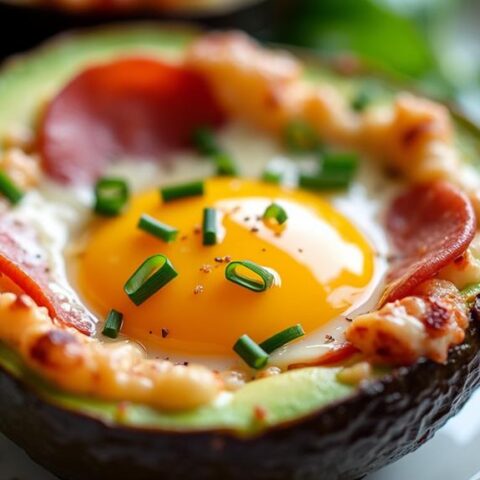

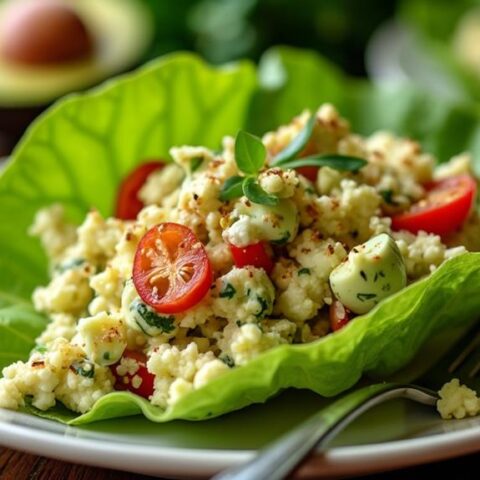

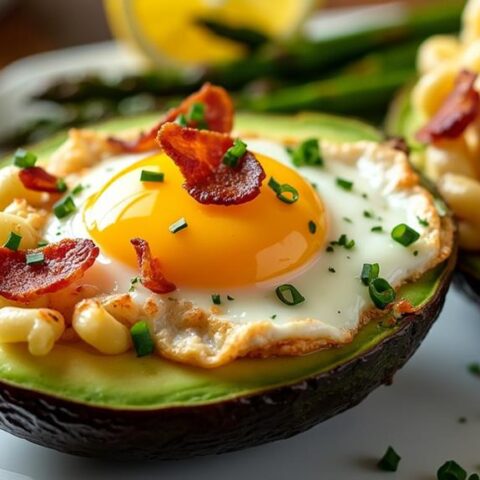
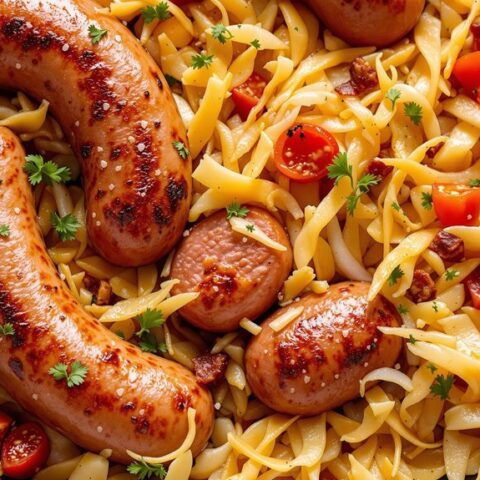
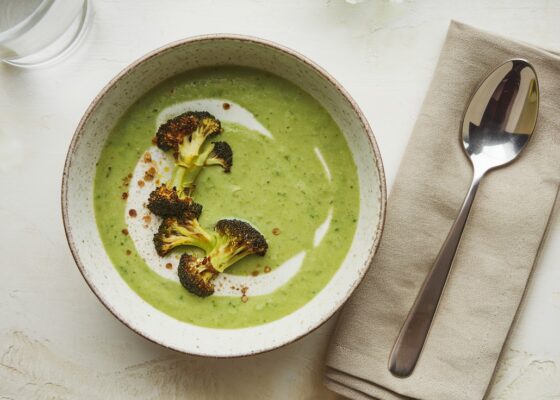

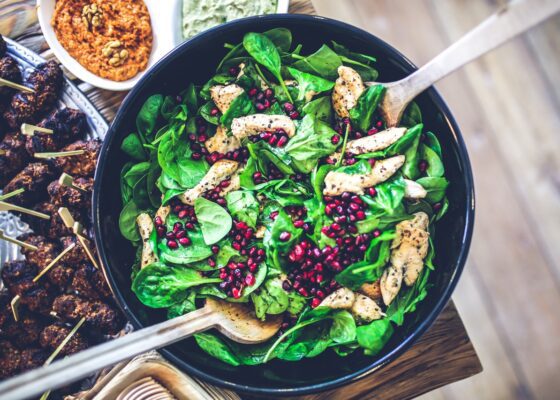
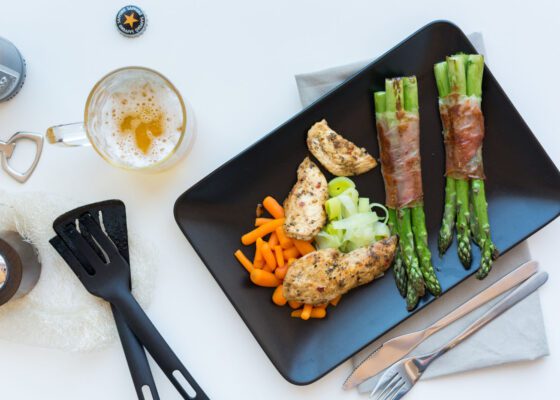
No Comments